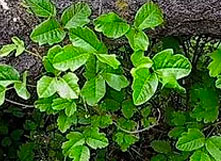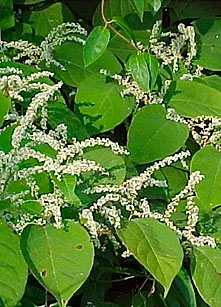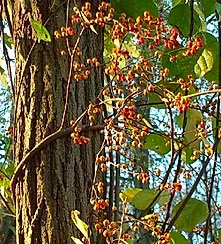Emerald Acres performs many services that can make a valuable addition to your landscape. One such service is clearing out undesirable plants like Poison Ivy, Japanese Knotweed and Bittersweet. The following article shows how small areas can be effectively treated by the homeowner. For larger scale treatment we can eliminate the problem for you.
POISON IVY

Poison Ivy, Poison Oak, and Poison Sumac all contain the allergen urishol in their roots, stems, and fruits. Exposure from direct and indirect contact with urishol will cause an allergic reaction in 60% to 80% of people within 24-36 hours. Some sources of indirect exposure are clothing, tools, pets, or even smoke from burning poison ivy covered brush. The allergic reaction takes the form of a blistery, itchy rash. Blister fluid will not spread the rash to other parts of the body or to other people. New lesions that develop after primary breakout represent a less sensitive area or areas where fewer antigens were deposited. It will usually take about 15 minutes for the urishol to bind with skin proteins. Therefore, if washed with soap and water within that time, an allergic reaction can be prevented. Once bound to cell membranes, urishol is next to impossible to remove and a full blown immune response will occur.

Poison Ivy leaves are red in early spring and turn a dark and sometimes shiny green during the summer. They will turn to orange or red in the fall before dropping. Leaves are harder to bruise when more mature so they are more contagious in the early part of the season. Poison Ivy has several growth habits. It frequently is found in wooded areas as a ground cover or climbing vine, but it can also take the form of a free standing shrub. Each leaf is made up of three leaflets, two opposite of each other and one in the center. Small greenish flowers will grow in bunches where the leaves meet the stem. Flowers mature in to berrylike clusters that have a whitish, waxy appearance. The three leaf characteristic is easily identified, prompting the wise refrain “Leaves of three, let them be”!
The best way to deal with Poison Ivy is through chemical treatment. The most effective product is Glyphosate (Round Up). The key to effective control is proper application timing. Permanent control can be achieved with a single application if applied when the plant is mature. Make sure the foliage is full and green. Treating too early will not allow the control to be distributed throughout the plant. Once the plant begins to turn to fall colors, it is too late for treatment. At this stage the plant is going in to a dormant state and distribution will again be incomplete. The plant will begin to die off within about two weeks. Do not pull up dead vines with your bare hands, the urishol can remain active for up to five years. Either let them decay on their own, or dress in a long sleeved shirt, long pants, and gloves before removing them yourself. Make sure to shower when complete and launder contaminated clothes.
JAPANESE KNOTWEED

Commonly known as American Bamboo, Japanese Knotweed (Polygonum Cuspidatum) is an extremely aggressive species that is capable of crowding out all other vegetation and is listed as a noxious weed. Additionally the plant can create a fire hazard in the dormant season by way of it’s large, cardboard-like stalks. As the name indicates, the plant is a native of Japan which escaped to England in 1825 for use as an ornamental. It subsequently found it’s way to North America and is now common from Newfoundland to California. The species forms dense stands that crowd out all other vegetation, degrading native plant and animal habitat.
Japanese Knotweed is a perennial that sprouts each spring from extremely vigorous, carrot-like rhizomes that form a dense mat below the soil surface. While capable of propagating by seed, the plant primarily propagates through growth of it’s rhizomes. The plant will also sprout from fragmented rhizomes wherever soil is moved, and is capable of translocating along streambeds making it an invasive fresh water weed. The plant reaches heights of four to eight feet with a cylindrical central stalk. The freely branched stems have petioled leaves that are oval in shape and six to eight inches long. Japanese Knotweed is exceedingly difficult to eradicate by traditional means (it will sprout through asphalt). Chemical treatment is the only viable control.
As with Poison Ivy, Glyphosate (Round Up) is the product of choice for Japanese Knotweed, and the timing is the critical factor in successful control. Begin by sheering the plant to the ground in late spring. This will tax the root system and weaken the plant. Allow the plant to re-grow for the remainder of the season. Knotweed will go into bloom in August producing clusters of small white flowers. This is the stage where the plant is storing nutrients in its rhizomes. It is critical that treatment is made during this stage as that is the only time of year that the plant will pull the herbicide into the roots. Spray Round Up over the top of the plant just to the point of runoff. It will take two to three weeks to control. One treatment can be all that it takes but in some dense groves we have had to re-treat the following year. The patch will be much much smaller but will eventually return if the second treatment is not performed.
BITTERSWEET
As Fall approaches, farm stands bustle with festive shoppers purchasing pumpkins, Indian corn and other adornments destined to decorate the doors and mailboxes of family homes. Among these traditional decorations will be big bunches of Bittersweet selling for $5.00 or more. The leafless vine, covered with yellow and orange berries, make beautiful wreaths and garlands, adding to the flavor of the season. However, if you’ve spent your weekends trying to eliminate the tangled viney mess from your backyard, their appearance may not conjure such a homey vision.

Oriental Bittersweet (Celastrus Orbiculatus), also known as Asiatic Bittersweet, is a rapidly spreading deciduous vine that threatens all vegetation in both open and forested areas. It engulfs other species, shading out the native vegetation. The twisting vine can grow to heights of 80 feet, and can cause trees to collapse from wind, snow, or excess weight alone. Twining vines will girdle trunks, constricting nutrient flow. This can kill the tree outright, or weaken it to the point where it is an attractive candidate for insect or disease infestation.
Oriental Bittersweet was imported from Asia in the 1800’s for erosion control along railroad beds. It was also used as an ornamental vine for trellises and fences and quickly became established in the eastern United States. Bittersweet is dispersed by birds who feed on the berries during the winter and by people who discard their arrangements in brush or compost piles. It has been shown to hybridize with the Native American Bittersweet (Celastrus Scandens) and may eventually destroy the native’s genetic integrity.
Control strategies differ depending on whether the vine is climbing, or growing as a dense mat. For vines simply cut the vine at the base and treat the ground end of the cut with Glyphosate (Round Up) or Tryclopyr (Garlon 3ATM, Brush-B-Gone). Use the appropriate label rate using a sponge or paint brush. Any hanging vines will decompose within two to three years. For low growing patches, mowing or cutting the vines weekly will discourage growth. Less frequent cutting, two or three times per year, will only encourage suckering and will not provide effective control. To permanently eradicate Bittersweet patches, cut all the vines at the base early in the growing season and let re-grow. One month later, spray the area with Tryclopyr (Garlon 3ATM, Brush-B-Gone) or Glyphosate (Round Up). This should eliminate the problem, however, it would be wise to inspect the area every few weeks and dig up any remaining sprouts that may appear.
An important word about pesticides
When using pesticides it is essential to read the entire label before use, and to follow all label directions. Included on the label are dilution rates for the specific weed you wish to control. Both Glyphosate and Triclopyr are non-restricted use products that can be purchased in most hardware and garden outlets. Triclopyr may be a better choice for patches of Bittersweet in that it is a selective herbicide that will not kill the monocots (grasses and bulbs). Glyphosate is non-selective and will kill all vegetation in the treated area. Both products have short residual lives. Glyphosate is also available under the trade name Rodeo and is labeled for use near water. If you are interested in contacting Emerald Acres for vegetation control, please call the office at (978) 897-0011 or email us at mail@emeraldacresinc.com.
Written By: Terence Boots
Massachusetts Certified Arborist
Owner: Emerald Acres Inc.
